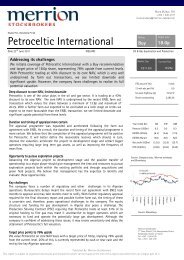Quarterly Bulletin Q3 2013
Quarterly Bulletin Q3 2013
Quarterly Bulletin Q3 2013
You also want an ePaper? Increase the reach of your titles
YUMPU automatically turns print PDFs into web optimized ePapers that Google loves.
33<br />
Financing Developments<br />
in the Irish Economy<br />
Overview<br />
Amidst a somewhat more volatile external environment in recent months,<br />
financing conditions for the Irish public and private sectors have remained<br />
relatively stable. Progress in implementing the measures required as part of<br />
the EU/IMF Programme of Financial Support has continued, and the yields on<br />
benchmark Irish sovereign debt are at levels last seen in 2005. Despite this,<br />
yields on Irish government bonds ticked upwards towards the end of Q2 <strong>2013</strong>.<br />
This is in line with wider market developments following the launch of the Cypriot<br />
official assistance programme and announcements by the Federal Reserve on<br />
the potential tapering of their quantitative easing measures towards the end of<br />
<strong>2013</strong>. The rehabilitation of the Irish-owned credit institutions has also continued<br />
as part of the EU/IMF Programme, with signs that more sustainable depositbased<br />
funding at affordable rates of interest is emerging. The banking system in<br />
Ireland continues to contract, however, as it deals with the high cost of impaired<br />
loan-books following the contraction in the property market and domestic<br />
economy generally.<br />
The non-financial private sector in Ireland also<br />
continues to adjust its balance sheet. Nonfinancial<br />
corporations (NFCs) saw a reduction<br />
in financial assets and debt positions in Q4<br />
2012 arising from certain companies moving<br />
their headquarters out of Ireland, but this<br />
was more than offset by strong inflows from<br />
foreign-owned multinational companies into<br />
their Irish operations. However, the underlying<br />
trend of NFCs deleveraging in the light of a<br />
challenging environment for expansion and<br />
investment, and management of previously<br />
incurred debt, remains prominent, particularly<br />
so for small- and medium-sized enterprises<br />
(SMEs). Resident credit institutions’ loans<br />
outstanding to NFCs continue to contract, with<br />
a slight increase in the pace of contraction in<br />
the first quarter of <strong>2013</strong>. Similar developments<br />
are evident for SMEs, and were seen across a<br />
number of business sectors.<br />
For households, aggregate debt levels have<br />
fallen again in recent quarters, with the decline<br />
evident during Q4 2012 being the largest<br />
quarterly decline recorded since mid-2010.<br />
This was driven by net repayment of loans by<br />
households, predominantly to resident credit<br />
institutions. The latest banking data suggests<br />
that this trend has continued into Q1 <strong>2013</strong>,<br />
with the pace of decline in credit institutions’<br />
loans outstanding to households increasing<br />
marginally to approximately 4 per cent yearon-year.<br />
The reduction in overall liabilities was<br />
the dominant factor in a rise of household net<br />
worth during the last quarter of 2012. This<br />
represents the second consecutive quarterly<br />
rise in net worth following over four years of<br />
steady decline, primarily as a result of the drop<br />
in the value of housing assets. Underlying<br />
these aggregate developments, a significant<br />
proportion of households continue to face<br />
difficulties in servicing their mortgage debt. At<br />
end-March <strong>2013</strong>, 12.3 per cent of all private<br />
residential mortgage accounts for principal<br />
dwelling houses (PDH) were in arrears of over<br />
90 days. The trend emerging among longerterm<br />
arrears continues to be of particular<br />
concern, as the number of PDH accounts in<br />
arrears of over 360 days rose to over 54,000<br />
or 7 per cent of the total stock. Resolving




